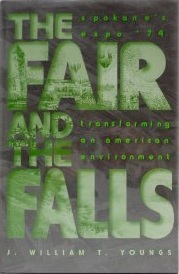The Fair and the Falls: Spokane's Expo '74: Transforming an American Environment

In the 1970s, Spokane, Washington became the smallest city ever to host a world's fair. The fair was dedicated to the theme of environmentalism and was itself an environmental triumph. The heart of the fair was on two islands in the Spokane River beside the thundering falls at the core of downtown Spokane.
When James Glover, the "Father of Spokane," first settled near this site in 1873, the setting was one of the most beautiful in the West. Over the years, the early settlers surrounded the falls with saw mills, flour mills, bridges, railway depots, warehouses, and other urban "improvements." In the process, they built a city but lost track of their river. Many Spokanites would later admit, "We'd forgotten it was there."
During the 1950s and 1960s Spokane suffered from the urban blight common to many American cities at the time. In order to restore the downtown, Spokanites considered a number of plans and eventually decided to host a world's fair -- a gigantic task for a small city. The fairgrounds were built, exhibitors and tourists came to Spokane from throughout the world, and the blighted region by the falls was transformed into a magnificent park.
In autumn 1996, Eastern Washington University Press published a history of these events. The Fair and the Falls is the most thorough account of any American exposition since World War II. The author, prize-winning historian J. William T. Youngs, and his student assistants conducted hundreds of interviews and read thousands of documents to prepare the text.
The Fair and the Falls is a narrative history of a place, Spokane Falls, and an event, Expo '74. This web site provides information about the book and its characters.
When James Glover, the "Father of Spokane," first settled near this site in 1873, the setting was one of the most beautiful in the West. Over the years, the early settlers surrounded the falls with saw mills, flour mills, bridges, railway depots, warehouses, and other urban "improvements." In the process, they built a city but lost track of their river. Many Spokanites would later admit, "We'd forgotten it was there."
During the 1950s and 1960s Spokane suffered from the urban blight common to many American cities at the time. In order to restore the downtown, Spokanites considered a number of plans and eventually decided to host a world's fair -- a gigantic task for a small city. The fairgrounds were built, exhibitors and tourists came to Spokane from throughout the world, and the blighted region by the falls was transformed into a magnificent park.
In autumn 1996, Eastern Washington University Press published a history of these events. The Fair and the Falls is the most thorough account of any American exposition since World War II. The author, prize-winning historian J. William T. Youngs, and his student assistants conducted hundreds of interviews and read thousands of documents to prepare the text.
The Fair and the Falls is a narrative history of a place, Spokane Falls, and an event, Expo '74. This web site provides information about the book and its characters.
Table of Contents
Part I: Possessing the Falls
Chapter One: James Glover: Purchasing the Falls
Chapter Two: Waiting for the Indians
Chapter Three: Harnessing the Falls
Chapter Four: "The World's Fair of the Northwest"
Chapter Five: The City Beside the Falls
Chapter Two: Waiting for the Indians
Chapter Three: Harnessing the Falls
Chapter Four: "The World's Fair of the Northwest"
Chapter Five: The City Beside the Falls
Part II: Rediscovering the Falls
Chapter Six: The Twilight of Old Spokane
Chapter Seven: Urban Blight and Urban Renewal
Chapter Eight: King Cole and The Heart of a City
Chapter Nine: Visualizing a World's Fair
Chapter Seven: Urban Blight and Urban Renewal
Chapter Eight: King Cole and The Heart of a City
Chapter Nine: Visualizing a World's Fair
Part III: Redesigning the Falls
Chapter Ten: From Spokane to Paris
Chapter Eleven: Wooing the Foreign Exhibitors
Chapter Twelve: Wooing the Domestic Exhibitors
Chapter Thirteen: The Environmental Debate
Chapter Fourteen: Building the Fair
Chapter Fifteen: Marketing, Money, and Management
Chapter Eleven: Wooing the Foreign Exhibitors
Chapter Twelve: Wooing the Domestic Exhibitors
Chapter Thirteen: The Environmental Debate
Chapter Fourteen: Building the Fair
Chapter Fifteen: Marketing, Money, and Management
Part IV: The Fair by the Falls
Chapter Sixteen: Opening Day
Chapter Seventeen: A Mingling of Peoples
Chapter Eighteen: Days at the Fair
Chapter Nineteen: The Press of New Ideas
Chapter Twenty: The Final Tally
Chapter Seventeen: A Mingling of Peoples
Chapter Eighteen: Days at the Fair
Chapter Nineteen: The Press of New Ideas
Chapter Twenty: The Final Tally
